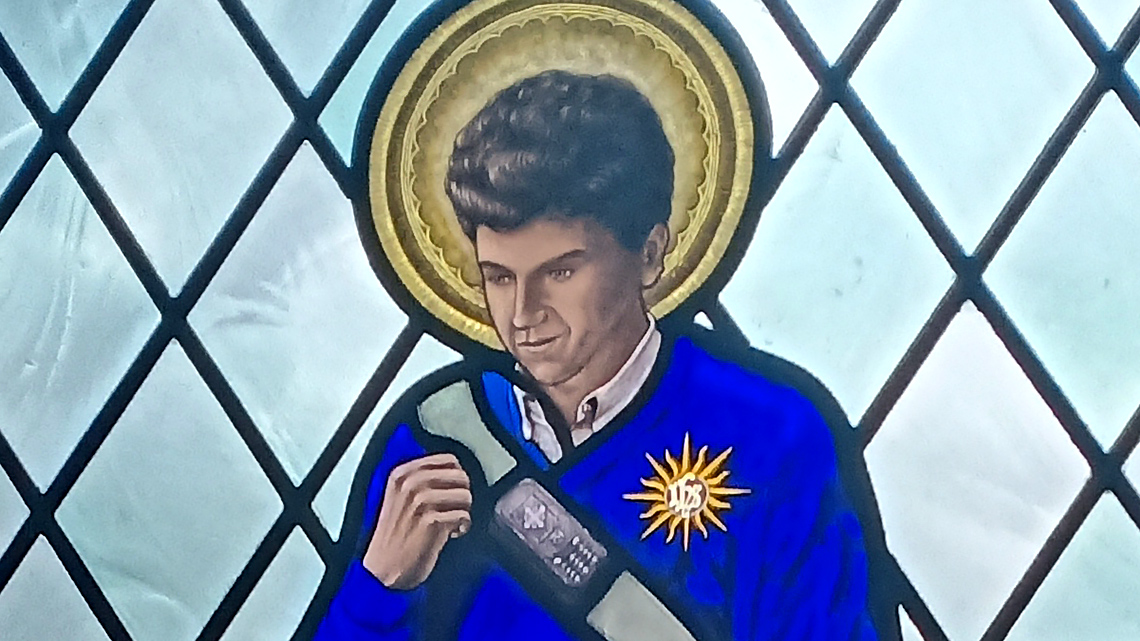Stained glass window of Blessed Carlo Acutis at St Aldhelm’s in Malmesbury | CBCEW
A parish in Wiltshire is believed to be one of the first in the country to commission a stained glass window dedicated to ‘Millennial Saint’ Blessed Carlo Acutis.
Artist Michael Vincent created the piece for St Aldhelm’s in Malmesbury using methods that have remained unchanged for hundreds of years.
Millennial Saint
Blessed Carlo was just 15 when he died of leukaemia but the millennial, an avid computer programmer, was a devout child with a great affection for the Blessed Sacrament and for reciting the Rosary. He rarely missed an opportunity to attend daily Mass and to this day inspires thousands of young people worldwide.
Although not yet a saint, London-born Carlo can be venerated in a church with special permission from the local diocese.
Artwork
The stained glass at St Aldhelm’s shows a smiling Blessed Carlo with a mobile phone in the strap of his rucksack, a watch on his left arm and the IHS symbol on his top. One of Blessed Carlo’s most popular quotes can be read under the image: “The Eucharist is the highway to heaven.”
Futureproofing
A second miracle needs to be attributed to the intercession of a man or woman on the path to sainthood so some time may pass before Blessed Carlo Acutis is canonised and declared a saint. This is something the parish has considered. A replacement pane of glass that modifies the ‘Bl.’ before his name to ‘St.’ will be kept safe until that joyous time arrives.
The window has been created with the structure of the church and its other windows in mind. There are already stained glass windows installed dedicated to St Aldhelm, Our Lady, the Sacred Heart, St Joseph and Our Lady of Guadalupe.
The Process
After the initial design, artist Michael Vincent produced a full-sized drawing called a ‘cartoon’ that offered a blueprint of the window that could be used for glass cutting and lead lines.
At this stage the glass was chosen and cut to suit the lead matrix. In this case. Mr Vincent used a variety of glass – mostly mouth-blown glass from the UK and Germany – including some flashed glass where the flashed surface is dissolved using hydrofluoric acid so more colours can be used within one pane of glass.
After this, painting begins. The aim here is to essentially paint with light, first by painting the trace lines to give an outline to work with. Next the glass is waxed up onto a large sheet of clear glass which can be put up to the studio window utilising a natural light source.
‘Matting’ comes next, where several layers of paint are applied to the glass using various brushes and techniques. When the paint is dry it can be removed and worked with stiff or soft brushes to let light through where needed. Various techniques can be used to achieve different effects.
Between applications of paint, the glass is removed from the easel and placed in a kiln. Firing in the kiln, at temperatures of up to 650°C, fuses the paint to the surface of the glass creating a permanent bond. The majority of the glass paint used is black, bistre, amber and silver stain. Interestingly, many of the colours you see are generated by the raw glass itself and not the paint.
When this stage is complete it can then be leaded together using Cames; a U-Channel shaped lead section the glass slots into which then is bonded together with a gas iron forming the structure of the window.
The window is then cemented using a form of runny black putty that is used to waterproof and strengthen the window when cured. Finally, a thorough clean and polish takes place and the window is ready for installation.
Source: CBCEW

